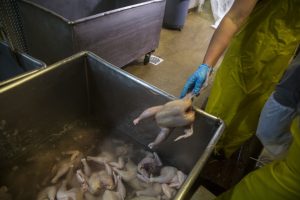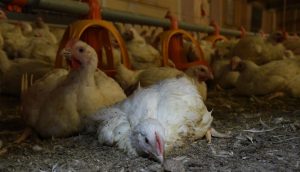The chicken I’ve been eating is washed in chlorine?
Urgh, yet another government mess to worry about.
Were it not for all the recent Brexit articles; I wouldn’t have known washing U.S. chickens with chemicals was even a thing.
With Brexit looming, the UK is shopping around for ways to open up trade with countries outside of the EU.
Enter Trump and Pence, who are both working double overtime with Boris Johnson to provide among many other U.S. goods and services; chemically-washed chickens.
As part of their trade talks, the U.S. is trying to convince the UK to accept U.S. food standards, that in many cases are subpar to theirs.
I suppose I shouldn’t be surprised that standards that are perfectly acceptable in the United States are illegal in Europe.
Let the Brits eat chicken… Saturated with chlorine.
I know what you’re thinking, and okay, I agree. Who would EVER choose to eat chlorine-soaked chicken? I certainly wouldn’t.
But low and behold, I have indeed been eating those subpar USDA approved suckers. And since chicken is my meat of choice, I have been eating a ton of them.
Yep, subpar chickens. That’s the latest and greatest Trump-Pence sales pitch.
Subpar? Who cares? If it’s good enough for the citizens of the United States, it should be good enough for UK citizens, right?
Not according to the EU, who has been dead set against using chlorine to wash chicken carcasses, and banned the process twenty-two years ago—in 1997.
The EU rule prohibits the use of anything other than water to decontaminate meat and effectively bans U.S. imports of poultry treated with chemical rinses in an attempt to eradicate bacteria and fungus.
An additional EU concern is that the U.S. chemical decontamination process could encourage resistance to antibiotics.
Apparently, antibiotic resistance is also a thing.
Experts have been warning that we are close to the point where humans worldwide may find themselves without effective life-saving drugs, which could escalate into a global health crisis.
The EU is adamant that food manufacturers focus on top-of-the-line hygiene rather than using chemicals to eliminate bacteria and disease.
Duh, makes sense to me.
But not to the good old U.S. Department of Agriculture (USDA).
The USDA is perfectly fine with unhygienic processes, and have no problem with the soaking of our poultry in chemical rinses, including acidified sodium chlorite, trisodium phosphate, peroxy acids, and chlorine dioxide.
(My grandmother used to say that if you can’t pronounce the ingredients on a label, don’t eat it.)
But I digress. Back to chemically washed chicken carcasses.
Now that the UK is preparing for post-Brexit, they are free to change up their rules. They don’t have to adhere to anything the EU says.
EU Shmee-U
Lucky for the Brits, post-Brexit, they too will be free to buy and eat all the U.S. subpar chlorinated chicken they want!
Not so fast, say the Britons, who are extremely unhappy that below par, unhygienic chicken from the United States may soon flood their markets.
Aw come on…what’s wrong with providing the UK with a flood-load of chemically washed chickens that hopefully got rid of all that harmful bacteria due to unhygienic U.S. practices?
We’re allies, right?
For all my sarcasm, let’s be clear here.
Chlorine-washed chickens are just one example of subpar U.S. regulations vs. the EU rules regarding food safety, animal welfare, and environmental standards.
As an example, in the EU, there is a legal minimum amount of space, ventilation, and lighting for EU poultry houses.
Not so in the United States.
Thus, the reason the U.S. needs to wash their chickens with chemicals.
There are ZERO laws governing the amount of space, ventilation, and lighting needed, because, you know how the U.S. feels about the almighty dollar.
It’s always about the bottom line.
Because there are no rules and regulations regarding poultry space, ventilation, and lighting, U.S. produced chicken is a fifth cheaper than in the UK.
And the chlorine is free.
The U.S. poultry houses have complete unregulated control over how many birds they can stuff into their artificially lit sheds—so they cram up to a whopping 20,000-30,000 chickens into a poultry facility.
The result? Production costs are indeed kept low, but the risk of disease and contamination are sky-high.
Low cost, high risk.
Because U.S. chickens are packed together so tightly, the birds have limited to no movement, with little light or ventilation.
And as a result of not being able to move, the chickens are forced to wallow in filth, resulting in rotting skin diseases, which spread from bird to bird at lightning speed. (BTW: Until doing this research, my favorite part of a chicken used to be the crispy skin. Ew.)
Additionally, their food and water are full of mass doses of antibiotics and other drugs to control parasites, but without any legal requirements who knows if the process of bird-medicating is safe, or if it even works?
As if that isn’t enough reason to question the lack of U.S. rules and regulations, the poultry houses aren’t cleaned until the end of each production cycle. So, the birds sit in feces and disease for at least two to three weeks.
Leave it to the U.S. to approve bathing chickens in a liquid recipe of chemicals to hopefully eradicate their bacterial diseases, because it’s a whole lot cheaper than clean, regulated hygiene procedures.
And chemical washing has other advantages:
Not only does the process hide odors and skin slime, but the meat can be passed off as fresh for way way longer than it should be.
And since common sense hygiene is not required, who’s to know if the heavily soiled birds are sufficiently disinfected? Is there a regulated bath time?
And relying on chlorine washing may well lead to more reduced hygiene standards overall.
They’re (supposedly) washing the chickens anyway so why waste time with cleanliness?
Don’t forget the old U.S. adage; time is money.
Chlorine isn’t supposed to be toxic at the levels used in the washing process and isn’t supposed to cause cancer.
But studies have shown that the washing process can cause dangerous carcinogens to form in the chicken meat if the concentration of chlorine is high enough.
And even though the U.S. Food Safety and Inspection Service have set chlorine limits to protect us from cancer toxicity, I’m not buying that every slaughterhouse follows the rules.
Right after I finish writing this blog post, I’m going to do my homework and see what kind of chicken I can eat that hasn’t been swimming in feces or bathed in chemicals. I suggest you do the same.
But I’m not finished with this post yet.
As if chicken skin sopping in feces isn’t bad enough, the neck and organs can also be severely diseased and bacterially compromised.
So why the hell do they pack that stuff into the cavity of our already at-risk chickens?
The statistics speak for themselves:
There are hundreds of recorded salmonella deaths a year in the U.S.
The UK has in recent years recorded none.
I’m no expert in chicken cooping, but it doesn’t take a genius to know that keeping chickens in filthy conditions will produce an unclean product.
Post-Brexit, the UK is free to change the rules and eat any kind of cooped-up chicken they please. After all, it’s a free of the EU country.
No regulations, no rules mean that untold numbers of U.S. slaughterhouses and processing plants rely heavily on chlorination because their hygiene standards are pathetic at best and non-existent at worse.
And the UK wants to cut a chicken deal with us, because?


This is so horrific, disgusting and intolerable. I will be checking as well!!! What else can be done?? Thank you for this information!! Reading your blogs are always informative!! You are the best!!!!
Thanks as always for being one of my biggest supporters. Last night, as the two of us Googled away, we were able to find one brand we could eat without worrying about bleach and chlorine. WHEW. For my readers, we found the following brand: Mary’s Free Range Chicken (Pittman Family Farms). The Pros: Their commitment to animal welfare, their chickens are free-range, organic, and pasture-raised, and they use an “air-chilled” process, which means no bleach or chlorine. The Cons: Their price per pound is high, especially for their pasture-raised products. (Chicken breasts are $10 per pound & whole chickens are $8 per pound.) Mary’s chicken can be found in Whole Foods or via online retailers, although shipping to destinations in the eastern U.S. states is expensive. If anyone knows of any other brands, please share!
“Air Chilled” does not mean No Chlorine, “Air Chilled” chicken, even organic and free-range, in the US is treated with a CHLORINE SPRAY instead of the typical CHLORINE BATH.
There is no mention on the Mary’s Chicken website or packaging that states No Chlorine was used. Even Whole Foods Market won’t say whether or not any of the chicken they sell, which is Mary’s Chicken has been treated with chlorine or not, they say to contact Mary’s Chicken.
But I can confirm personally that the Mary’s Chicken feet sold at Whole Foods Market, do contain enough chlorine that the smell was obvious, and even made me gag and vow to never buy again.
Mary’s Chicken is just a marketing ploy with no real integrity or transparency, just like the rest of the US food industry.
Would love to buy unchlorinated chicken feet for my dogs but has been impossible to find.
This chlorinated chicken practice is disturbing and the US poultry industry deserves to be shut out of every country for trying to get away with cutting every corner and supporting disturbing practices.
Thank you, Brexit for educating the US public on how disturbing the USDA and our animal farm practices are.
Bell & Evans specifically states that they do not use chlorine on their website. I was looking for a company this morning. They also sell at my local whole foods.
I will check out Bell & Evans! Thank you!